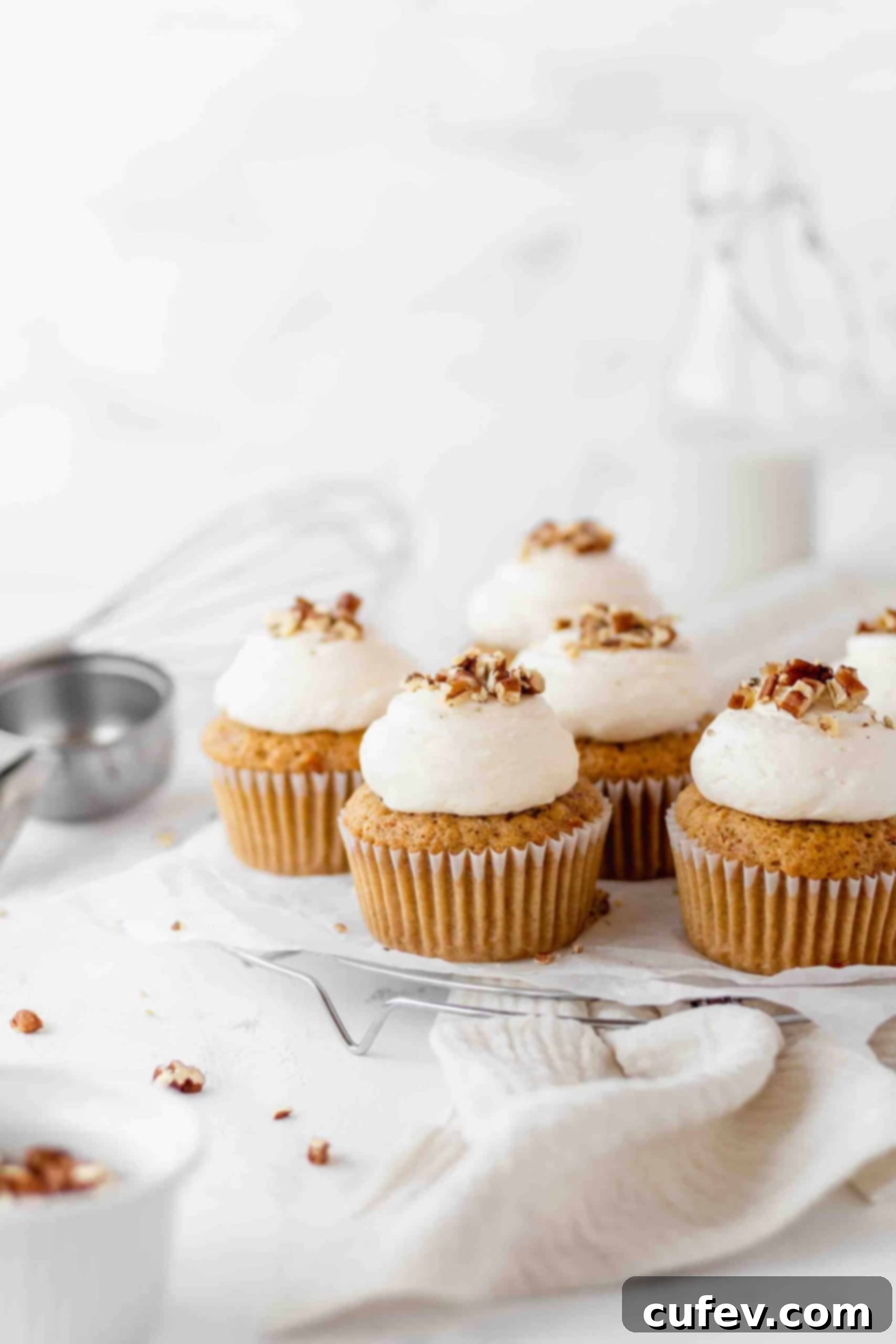Irresistible Fluffy Carrot Cake Cupcakes with Zesty Lemon Cream Cheese Frosting
Experience the ultimate delight with these incredibly fluffy and moist carrot cake cupcakes, perfectly crowned with a luscious, tangy lemon cream cheese frosting. Whether you’re planning for a festive Easter brunch, a heartwarming Mother’s Day celebration, or simply craving a taste of springtime bliss, these individual treats are the quintessential dessert. Their vibrant flavors, tender crumb, and beautiful presentation make them an absolute showstopper for any gathering, promising to impress every palate.
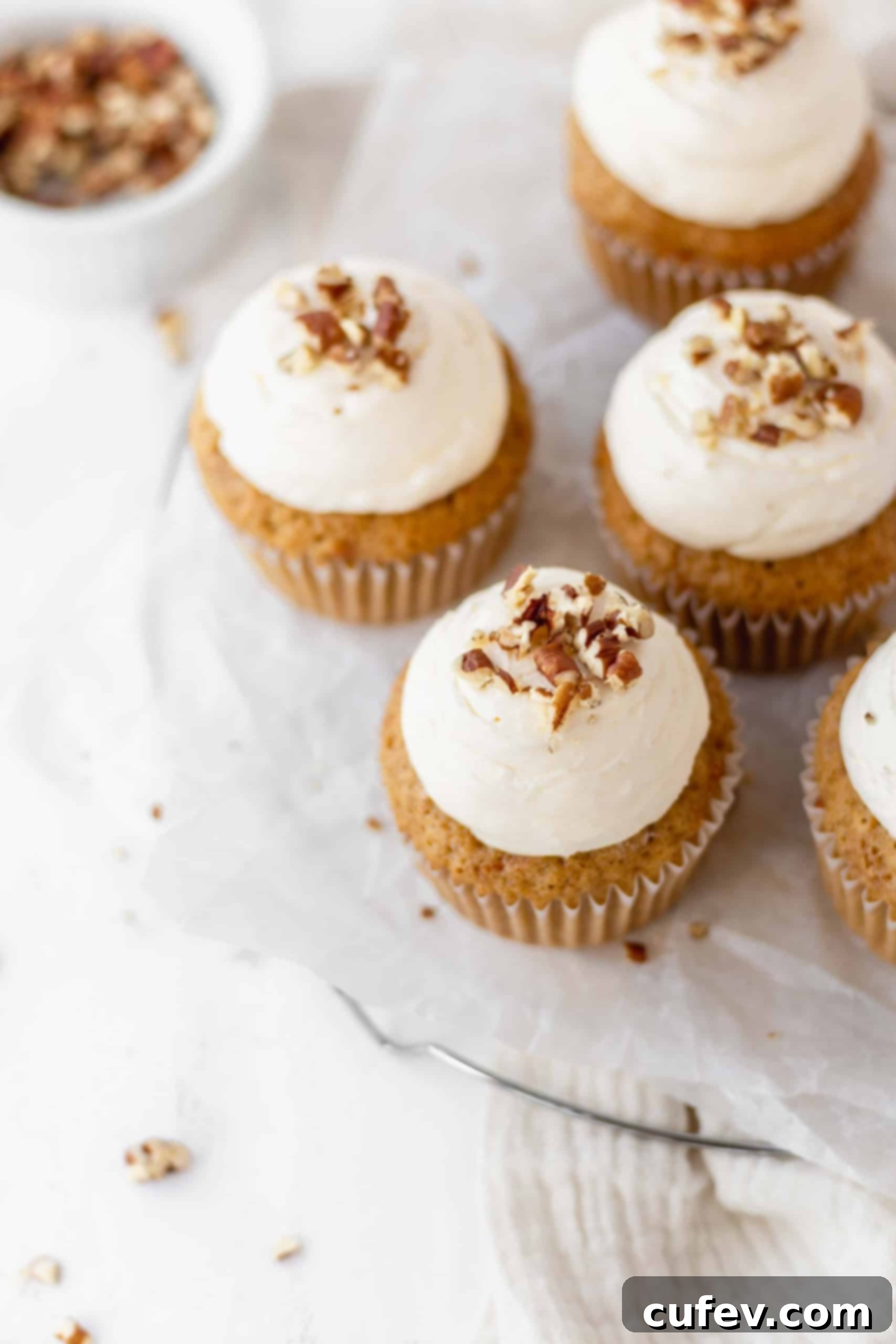
The Secret to Irresistibly Fluffy Carrot Cake Cupcakes with Zesty Lemon Cream Cheese Frosting
My culinary journey to creating these perfect carrot cake cupcakes began with a deeply cherished family recipe – my late mother-in-law’s magnificent carrot cake. This recipe, a precious culinary heirloom, holds a special place in our family and is one we’ve chosen to keep private. However, its profound deliciousness and incredible moistness inspired me to adapt its essence into a shareable form: these exquisite, fluffy carrot cake cupcakes. The adaptation process was a labor of love, aimed at capturing the original’s spirit while making it accessible to home bakers everywhere, with a few crucial tweaks for optimal cupcake texture and lift.
The original carrot cake recipe, while undeniably moist and flavorful, had a tendency to be quite dense and heavy. This was largely because it lacked a sufficient acidic component to react with the baking soda, which is essential for activating the leavening agent and creating a light, airy crumb. To counteract this and achieve that coveted “fluffy” texture in our cupcakes, I introduced a simple yet transformative ingredient: Greek yogurt. The subtle acidity of Greek yogurt works wonders, creating a chemical reaction with the baking soda that produces a beautifully tender and light crumb, elevating these cupcakes from merely moist to truly ethereal. This addition not only adds a lovely tang but also enhances the overall moisture content, ensuring each bite is a pure delight.
And what could possibly complement the warm, inviting spices of carrot cake better than a rich and creamy cream cheese frosting? It’s a classic pairing for a reason! To further enhance the bright, springtime feel of these cupcakes, I’ve infused the traditional cream cheese frosting with a generous amount of fresh lemon zest. This delightful addition cuts through the richness of the frosting, adding a vibrant, tangy note that beautifully highlights the cozy notes of cinnamon, nutmeg, ginger, allspice, and cardamom in the cupcake. The lemon zest doesn’t just add flavor; it brightens the entire profile, creating a harmonious balance of flavors that is simply divine and perfectly suited for the spring season.

Grating Carrots for Perfection: Fine vs. Coarse
One of the most crucial, yet often debated, aspects of making carrot cake or cupcakes is the consistency of the grated carrots. The size of your grated carrots can significantly impact the final texture and moisture content of your baked goods. This isn’t just about aesthetics; it directly influences the structural integrity and deliciousness of each bite. My own culinary experiments taught me this lesson firsthand, leading to some unexpected, and sometimes disappointing, results before I found the ideal method.
When I initially tested this cupcake recipe, I opted for the smallest holes on my grater, believing that finely grated carrots would disappear seamlessly into the batter, becoming virtually undetectable and providing an even texture. However, the outcome was far from ideal. The cupcakes emerged from the oven sunken in the middle, incredibly mushy in texture, and with a disappointingly wrinkled top. The culprit? Excess moisture released by the extremely fine carrot particles, which created too much liquid in the batter and interfered with its ability to rise and set properly. This experience was a clear indication that “more camouflaged” did not equate to “better texture” or a structurally sound cupcake.
For my subsequent attempt, learning from my previous mistake, I switched to the regular, medium-sized holes on the grater. This adjustment made all the difference. The carrots, grated at this size, maintained a bit more structure, allowing for a pleasing textural element within the cupcake without releasing an overwhelming amount of moisture. The slightly coarser grate allowed the batter to bake more evenly and develop proper structure. The result was a batch of perfectly domed, delightfully fluffy cupcakes that were moist without being soggy, and held their shape beautifully even after cooling. This experience solidified my recommendation: always use the regular-sized holes on your grater for the best balance of moisture, texture, and visual appeal in your homemade carrot cake cupcakes.
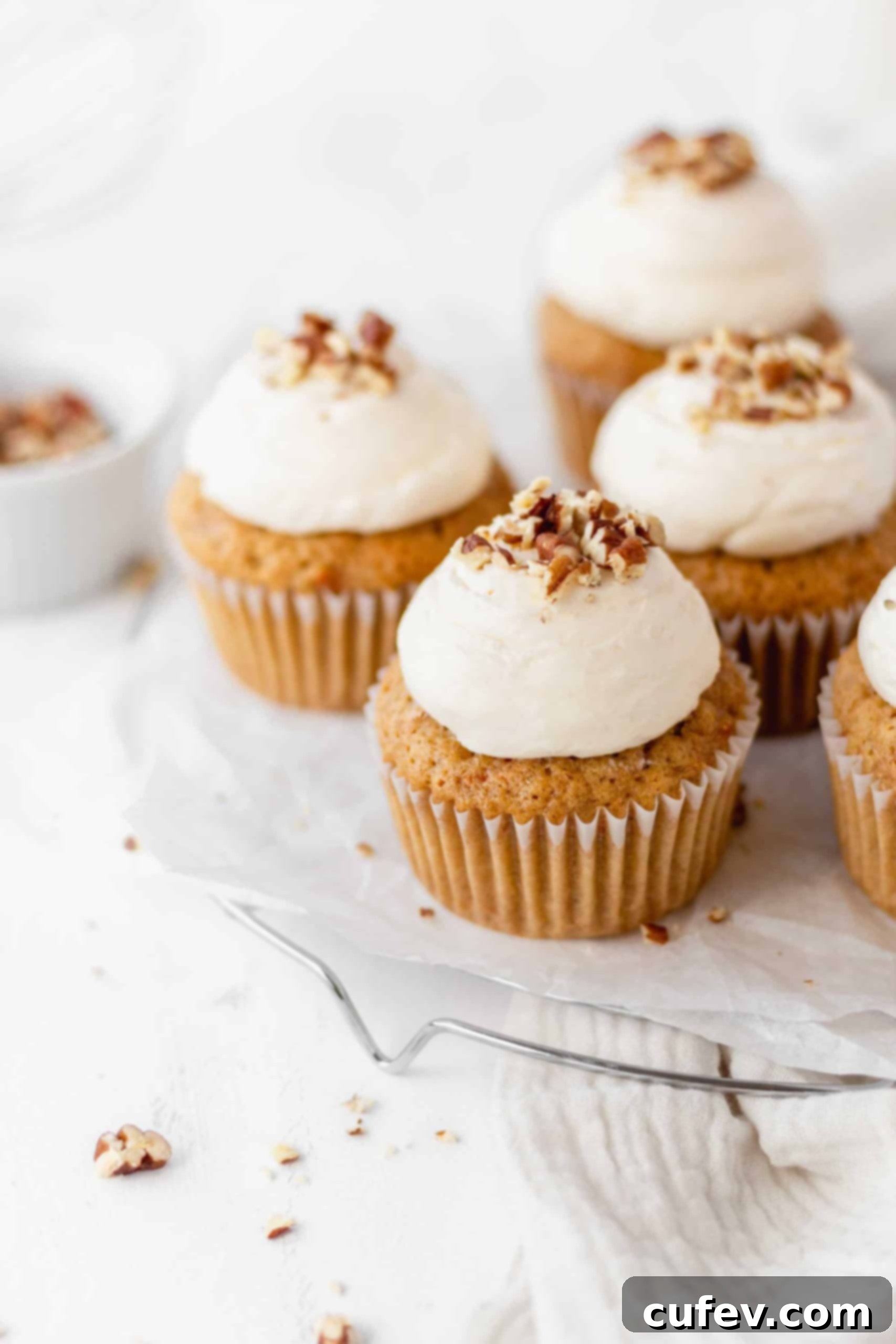
Crafting Your Carrot Cake Cupcakes: A Step-by-Step Guide
Creating these delightful carrot cake cupcakes is a straightforward process, but paying attention to each step ensures the best results – moist, tender, and perfectly spiced. The key lies in properly combining your ingredients and, crucially, not overmixing, which can lead to dense, tough cupcakes instead of the desired fluffy outcome.
Begin by preparing your dry ingredients. In a small bowl, thoroughly whisk together the cake flour, all-purpose flour, baking soda, baking powder, salt, ground cinnamon, nutmeg, ginger, allspice, and cardamom. Using a combination of cake flour and all-purpose flour contributes to the cupcakes’ uniquely tender crumb, with cake flour providing extra softness and the all-purpose flour adding a bit of structure. The baking soda and baking powder are your essential leavening agents, crucial for that desirable lift and fluffy texture, especially when they react with the added acidity from the Greek yogurt. Don’t underestimate the power of these warm spices; they are the heart and soul of traditional carrot cake, giving it its signature comforting and aromatic flavor profile.
In a separate, larger bowl, it’s time to prepare the wet ingredients. Combine the large eggs, light brown sugar, olive oil, Greek yogurt, and vanilla extract. Light brown sugar is preferred here not only for its sweetness but also because it contributes significantly to the moistness of the cupcakes and imparts a subtle, rich caramel note that complements the spices beautifully. Olive oil is chosen for its ability to keep the cupcakes incredibly moist and tender, often more so than butter, and it allows the pure carrot and spice flavors to truly shine without any buttery interference. The Greek yogurt, as mentioned, is our secret weapon for achieving a light and fluffy texture, while vanilla extract enhances and harmonizes all the other complex flavors. Whisk these wet ingredients together until they are well combined and smooth, ensuring the sugar has largely dissolved.
Now comes the pivotal step: gently incorporating the dry flour mixture and the grated carrots into the wet ingredients. The crucial instruction here is to mix until the batter is just combined. Overmixing can quickly develop the gluten in the flour too much, resulting in dense, tough, and chewy cupcakes. A few small lumps in the batter are perfectly fine and often preferred, as they indicate you haven’t overmixed. Once combined, scoop the batter evenly into a 12-cup muffin pan, which should already be lined with paper liners. Filling each cup about two-thirds full will ensure perfectly domed cupcakes that rise beautifully without overflowing.
Bake the cupcakes in a preheated oven at 320°F (160°C) for approximately 18 to 20 minutes. Baking time can vary slightly depending on your oven, so keep a close eye on them. They are done when a toothpick inserted into the center of a cupcake comes out clean or with a few moist crumbs attached. Allowing them to cool in the pan for a couple of minutes before transferring them to a wire rack is important, as it helps them set without falling apart. Ensure they cool completely on the wire rack before you even think about frosting them. Frosting warm cupcakes is a recipe for a melted, messy disaster, as the heat will cause your beautiful cream cheese frosting to liquefy and slide right off!
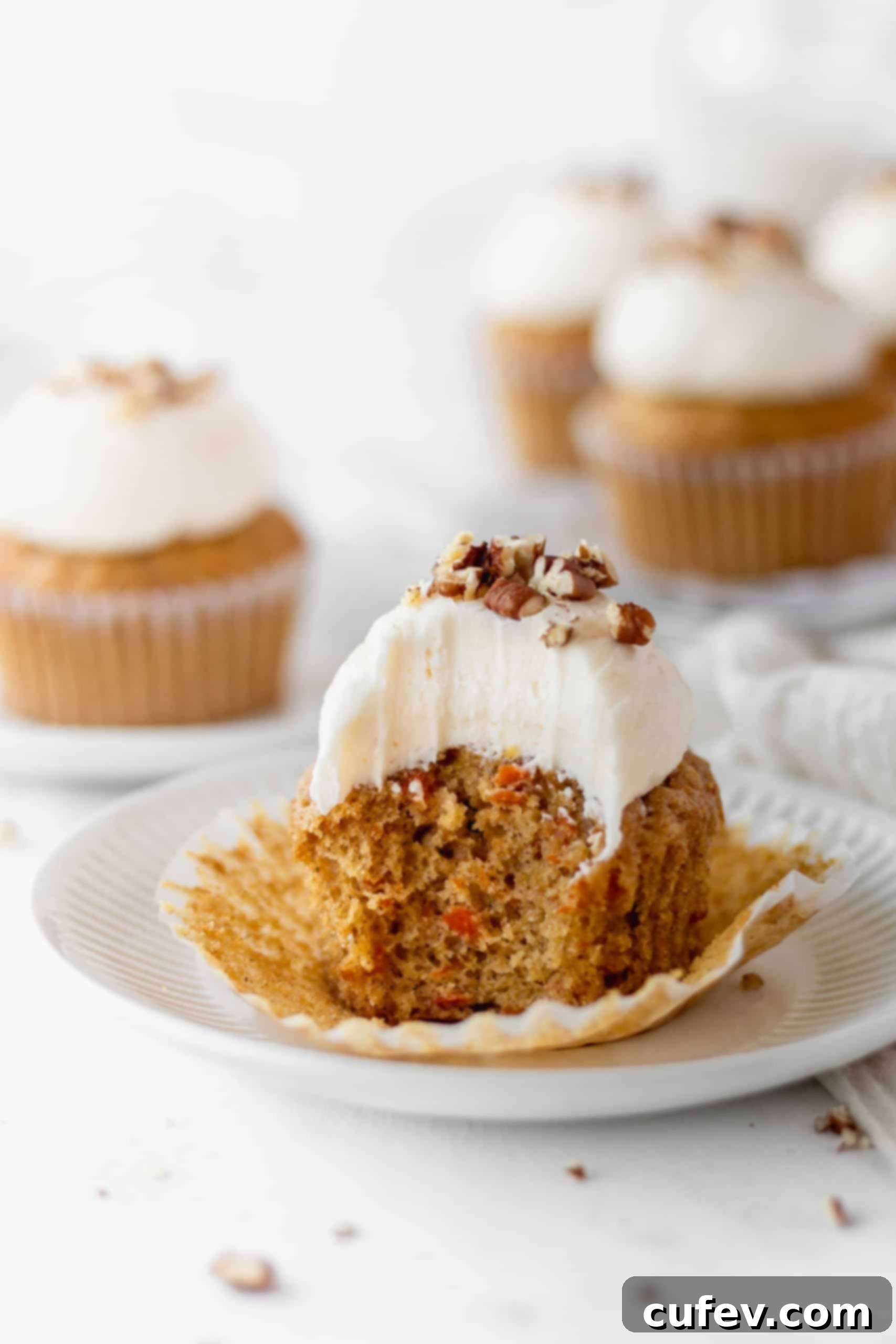
Whipping Up Zesty Lemon Cream Cheese Frosting
A truly exceptional carrot cake cupcake demands an equally exceptional frosting, and this lemon cream cheese frosting delivers on all fronts – it’s creamy, tangy, and utterly irresistible. The key to its perfect consistency and light, fluffy texture lies in starting with ingredients at the correct temperature and following a precise mixing order.
Begin by beating the unsalted butter in a spacious bowl until it becomes notably light and fluffy. It’s imperative that your butter is softened to room temperature, but definitely not melted, to achieve this airy texture. If the butter is too cold, it won’t cream properly, and if it’s too warm, the frosting will be runny. Once the butter is whipped to a pale, fluffy consistency, add the cream cheese. Like the butter, your cream cheese should also be at room temperature; cold cream cheese will result in a lumpy, unappealing frosting, while overly warm cream cheese can make the frosting too soft to pipe effectively. Continue beating the butter and cream cheese together until the mixture is completely smooth and well combined, ensuring there are absolutely no lumps of cream cheese remaining. This can take a few minutes, so be patient.
Next, slowly incorporate the powdered sugar, also known as confectioners’ sugar, into the butter and cream cheese mixture. Adding it gradually, perhaps in two or three additions, helps prevent a cloud of sugar from flying everywhere and ensures a smooth, lump-free frosting. This is also when you’ll add the star ingredient for that bright, refreshing flavor: freshly grated lemon zest. The zest, which contains the essential oils of the lemon, provides concentrated lemon flavor without adding excess liquid that could thin out the frosting, unlike lemon juice. Beat the entire mixture on medium-high speed until the frosting is light, fluffy, and has reached your desired creamy consistency. Taste and adjust sweetness or lemon intensity as needed; a little extra zest can go a long way.
Once your luscious frosting is ready, transfer it to a piping bag fitted with your favorite tip. I personally love using a large round piping tip to create simple, elegant domes on top of each cupcake, which gives them a polished, classic bakery-style look. However, feel free to get creative with any piping tip you prefer – a star tip for elaborate swirls, a petal tip for floral designs, or even just spreading it on with an offset spatula for a more rustic and homemade charm. Frost generously, as this tangy, sweet topping is truly the crowning glory of these carrot cake cupcakes, completing their irresistible charm.

Storing Your Delicious Carrot Cake Cupcakes for Lasting Freshness
Proper storage is essential to maintain the freshness and delightful taste of your carrot cake cupcakes, especially given their creamy lemon cream cheese frosting. These cupcakes are best kept in an airtight container in the refrigerator. Due to the dairy content and perishable nature of cream cheese frosting, it’s generally not recommended to leave them out at room temperature for extended periods. Food safety is paramount when working with dairy products, and refrigeration helps to keep the frosting firm, prevent spoilage, and ensures your cupcakes remain safe and delicious to enjoy for several days.
The excellent news is that these cupcakes age wonderfully. In fact, many people, myself included, find that their flavor actually improves and deepens the day after they’re baked. This is because the warm, inviting spices in the carrot cake have more time to meld and harmonize with the tangy lemon cream cheese frosting, resulting in a more integrated, complex, and even more delicious taste experience. I’ve personally enjoyed these cupcakes almost two full days after baking, and they were still incredibly tender, fluffy, and moist – a true testament to their excellent keeping qualities. So, don’t hesitate to make them in advance!
Making these cupcakes a day ahead makes them the perfect dessert for any springtime gathering, as it allows the flavors to fully develop and provides you with more precious time to spend with family or friends on the day of the event. Or, just as importantly, more time for yourself to relax and enjoy the occasion! If you prefer your cupcakes at room temperature for serving, simply take them out of the refrigerator about 30 minutes to an hour before serving. This allows the frosting to soften slightly to a more spreadable consistency and the cake to lose its chill, enhancing its texture and flavor. Stored correctly in the refrigerator, these delectable treats will remain fresh and flavorful for up to 3-4 days, ready to be enjoyed whenever a craving strikes.
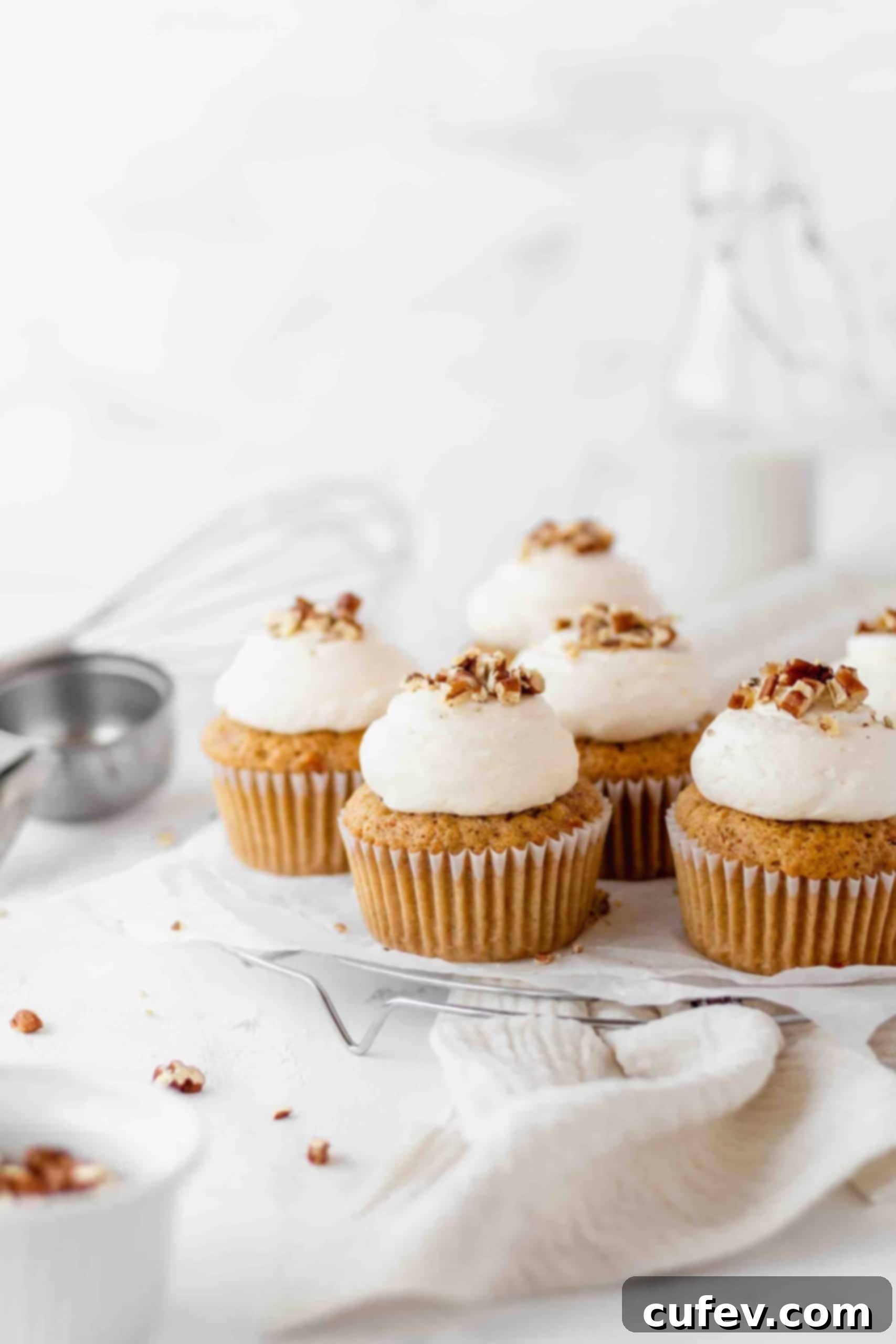
Frequently Asked Questions About Carrot Cake Cupcakes
Here are answers to some common questions about making and enjoying these delightful carrot cake cupcakes, ensuring your baking experience is as smooth and successful as possible:
- Can I add nuts or raisins to the batter? Absolutely! Adding 1/2 to 1 cup of chopped pecans, walnuts, or golden raisins (or a delightful mix of both!) to the batter along with the grated carrots will introduce wonderful additional texture and bursts of flavor. Just make sure to toss them lightly in a bit of flour first. This simple trick helps prevent them from sinking to the bottom of the cupcake liners during baking, ensuring even distribution throughout your cupcakes.
- What kind of carrots are best for carrot cake? Any fresh carrots will work beautifully. For the best flavor and moisture, choose firm, bright orange carrots. Avoid using pre-shredded carrots if possible, as they can sometimes be drier and lack the fresh moisture that freshly grated whole carrots provide, which can impact the final texture of your cupcakes.
- Can I make these cupcakes gluten-free? While this specific recipe is not designed to be gluten-free, you might be able to substitute the cake and all-purpose flour with a high-quality 1:1 gluten-free baking blend that contains xanthan gum. However, results can vary significantly with gluten-free substitutions, and a dedicated gluten-free carrot cake recipe might offer more consistent success for those needing to avoid gluten.
- Can I substitute Greek yogurt? If you don’t have Greek yogurt on hand, you can effectively use sour cream or buttermilk as a substitute. Both of these alternatives will provide the necessary acidity to react with the baking soda and contribute to a deliciously moist and tender crumb, similar to Greek yogurt.
- How do I know if my cream cheese and butter are at room temperature? Achieving the right temperature for your dairy ingredients is crucial for a smooth, lump-free frosting. Butter should be soft enough to indent easily with your finger but should still feel cool to the touch and hold its shape. Cream cheese should feel slightly soft when pressed. This usually takes about 30-60 minutes out of the fridge, depending on your room temperature and the specific product.
Explore More Delightful Cupcake Recipes!
If you’ve fallen in love with these carrot cake cupcakes, you’ll be thrilled to discover more delicious cupcake creations from my kitchen. Each recipe is crafted to bring joy and satisfy every craving, from timeless classics to unique, exciting treats, ensuring there’s a perfect cupcake for everyone!
- These dairy-free vanilla cupcakes are incredibly moist, wonderfully fluffy, and bursting with pure vanilla flavor, making them perfect for those with dietary restrictions or anyone who simply adores a classic.
- Are you a true chocoholic at heart? Then these incredibly moist chocolate cupcakes, rich, decadent, and deeply flavorful, are absolutely made for you.
- If you’re seeking a delicious and wholesome vegan option, these vegan banana cupcakes offer amazing moistness and a wonderfully natural sweetness that will surprise and delight.
- Want something that combines both rich chocolatey goodness and vegan-friendly ingredients? Look no further than these fantastic vegan chocolate banana cupcakes – a truly harmonious and delicious match made in heaven!
- These unique matcha cupcakes, delicately flavored and paired with a smooth, sweet white chocolate frosting, are a dream come true for all my fellow matcha lovers out there!
- Chocolate peanut butter cupcakes are the ultimate treat and the perfect choice for anyone who adores the timeless and utterly irresistible combination of rich chocolate and creamy, savory peanut butter!
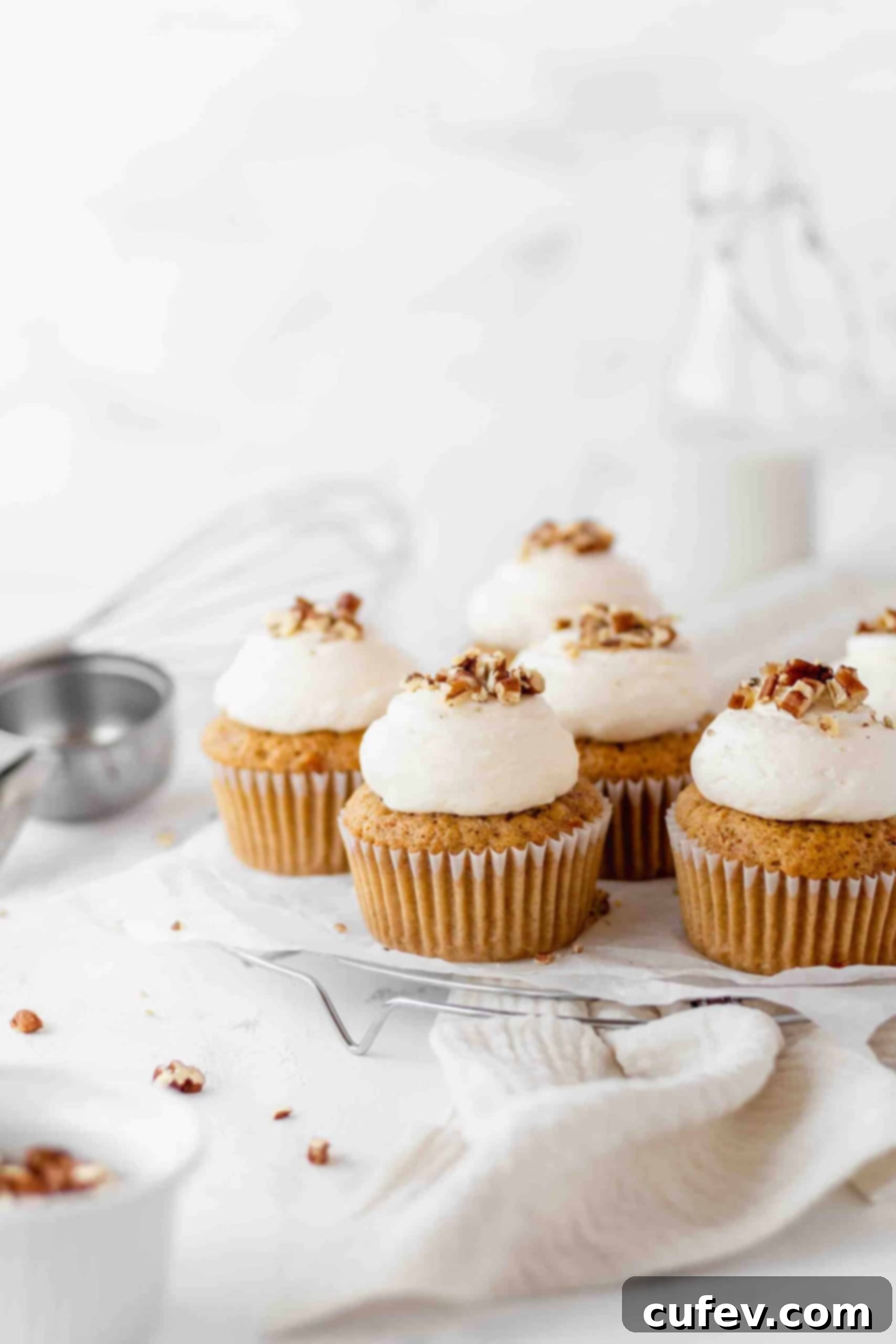
Carrot cake cupcakes with lemon cream cheese frosting
Print
Pin
Rate
Ingredients
Cupcakes
- 1½ cups grated carrots
- 1 cup / 120g cake flour
- ¼ cup / 31g all-purpose flour
- ½ teaspoon baking soda
- 1 teaspoon baking powder
- ¼ teaspoon salt
- ½ teaspoon ground cinnamon
- ⅛ teaspoon ground nutmeg
- ⅛ teaspoon ground ginger
- ⅛ teaspoon ground allspice
- ⅛ teaspoon ground cardamom
- 2 large eggs
- ¾ cup / 150g light brown sugar
- ½ cup / 120ml olive oil
- ¼ cup / 60ml greek yogurt
- ½ teaspoon vanilla extract
Frosting
- 8 oz / 225g cream cheese
- ½ cup / 113g unsalted butter, softened at room temperature
- 1½ cup / 188g powdered sugar
- ½ teaspoon grated lemon zest
Instructions
Cupcakes
-
Preheat the oven to 320°F/160°C and line a muffin pan with paper liners, and set aside.
-
In a small bowl, combine the cake flour, all-purpose flour, baking soda, baking powder, salt, and spices. Set aside.
-
In a separate bowl, combine the eggs, sugar, oil, greek yogurt, and vanilla extract.
-
Add the flour mixture and grated carrots and mix until just combined.
-
Scoop out the batter evenly and bake for 18 to 20 minutes. Let them cool in the pan for a couple minutes before taking them out to a wire rack to cool completely.
Frosting
-
In a bowl, beat the unsalted butter until it becomes fluffy. Add the cream cheese and continue to beat.
-
Beat in the powdered sugar and lemon zest.
-
Put the frosting into a piping bag and frost the cupcakes to your liking.
SAVE TO PINTEREST FOR LATER!
